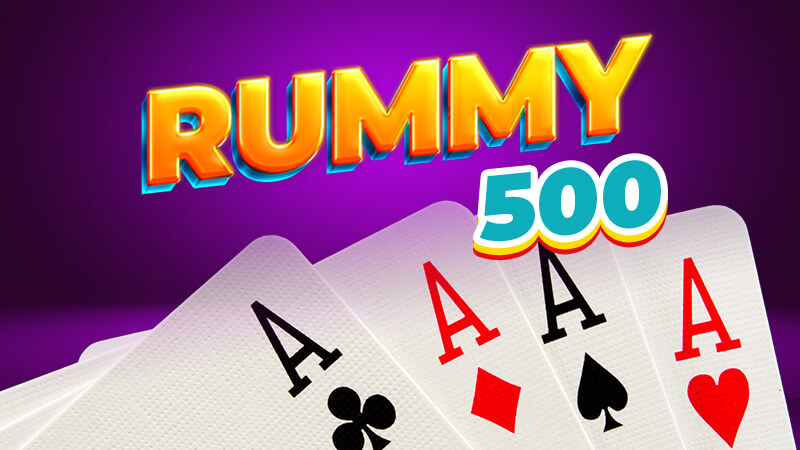Table of Contents
In this blog post, we’ll cover everything you need to know to get started, from setting up the game to advanced strategies that will elevate your gameplay.
Fun fact: Rummy 500 is sometimes called Pinocle Rummy. What’s so common between Pinochle and Rummy? Read our guide on Pinochle rules and find out!
1. Basic Rummy 500 rules
Players
To play the game of Rummy 500, you need a standard 52-card deck and a minimum of 2 players. Of course, the game can also be played with 2, 4, and 5 people.
Card ranking
The ranking of cards from high to low are K, Q, J, 10, 9, 8, 7, 6, 5, 4, 3, 2, and A.
Objective
The objective is to be the first player to obtain a total of 500 points.
Earn points by creating sets of 3 or 4 cards with the same number or sequences of 3 or more cards in the same suit. For instance, you can lay down three or four 7s or a sequence of 3, 4, or 5 diamonds.
2. How to play Rummy 500
Shuffle & deal your cards
The dealer shuffles the card deck and deals each player 7 cards. This is the standard of playing Rummy 500 with 3 or more players. If the game involves just 2 players, then the dealer gives 13 cards each.
Create a stockpile and a discard pile
The remaining cards should be stacked in the center of the table, forming the stockpile. Players will draw cards from this pile at the start of their turns. Next to the stockpile is the discard pile.
Draw a card from the stockpile
Commence each round by starting with the player positioned to the left of the dealer and proceeding in a clockwise direction. Each player begins their turn by selecting the top card from the stockpile and adding it to their hand.
Draw a card from the discard pile
Instead of selecting a face-down card from the stockpile, a player may opt for a card from the discard pile that they can immediately use. Before drawing from the discard pile, the player must be able to form at least one valid meld between the cards they pick up and the cards they already have in their possession for that particular turn. The remaining cards acquired from the discard pile can either be melded during that turn or added to the player’s hand.
Lay down melds
During their turn, players have the opportunity to lay down melds from their hand, which could consist of 3-4 cards of the same rank, like 3 Aces, 4 Jacks, or 3 2s. Melds can also take the form of 3 or more cards in a sequence of the same suit, such as the 10, Jack, and Queen of Hearts. Players can also extend existing melds already present on the table. The player cannot create a meld that starts before the Ace (e.g., starting at Kings, Queens, Jacks, etc.) and continues past the Ace (e.g., 2, 3, 4).
Discard
A player’s turn concludes when they play a card onto the discard pile. This action must be taken even if the card could have completed an existing meld of three cards or if it happens to be the player’s final card. All melds must be finished before discarding.
Keep playing for victory
At the end of each round, record and calculate the scores. Keep playing rounds in this manner until a player reaches a score of 500. If, in the same round, multiple players exceed 500 points, the player with the highest score is declared the winner.
3. Scoring
The game of Rummy 500 concludes when a player finishes all of their cards. At this point, scores are tallied up as follows: players who still hold cards in their hands calculate the value of those cards and then deduct that amount from their score for that round.
Card values vary based on their type. Number cards hold a value equivalent to their displayed number. Face cards, like Jacks, Queens, and Kings, are valued at 10 points each, while Aces are assigned a value of 15 points.
Alternatively, if the stockpile of cards runs out before a player goes out, the round also ends, but in this case, players do not subtract the value of their remaining cards from their score.
4. Additional rules
There are some additional, optional rules that you may like to use. Be sure to discuss these rules and accept or reject them before you begin gameplay.
- The 30-point rule. Players must accumulate a minimum of 30 points within a single round before they are eligible to contribute points to their overall score. Once players have achieved this threshold, any point value can be added to their total score.
- The Boathouse rule. This rule specifies that players are required to make a discard during each turn, even on the turn in which they successfully “go out.”
- The Stockpile re-fill rule. In the typical Rummy 500 game, when the stockpile is depleted, the round concludes. However, certain players may opt to reshuffle the stockpile and continue the game until one player successfully goes out.
- The Rummy rule. This rule establishes that whenever a player discards a card that could form a meld with an existing set on the table, the first player to declare “Rummy” has the opportunity to claim that card and place it in front of them, thereby earning the points associated with that card.
Now, read our comprehensive guide on How to Play Gin Rummy.


